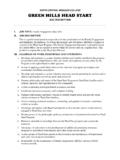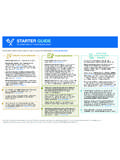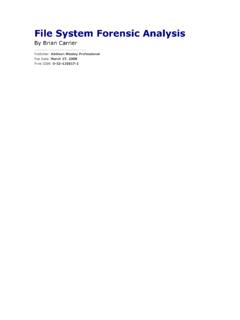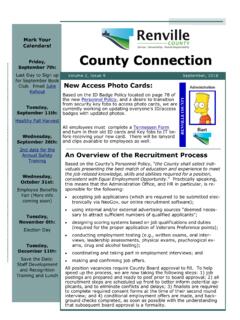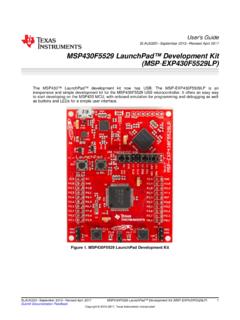Transcription of PERFORMANCE INDICATOR CHECKLIST FOR TEACHERS/FSA
1 PERFORMANCE INDICATOR CHECKLIST FOR TEACHERS/FSA NOTE: For more specific information, the teacher should refer to the various component plans and to the Head start PERFORMANCE Standards. EDUCATION CHECKLIST FOR teacher /FAMILY SERVICE AIDES I. DAILY ACTIVITIES: _____ Daily schedule and lesson plans posted in classroom. _____ Daily lesson plan provides for activities which enhance child's growth in the following areas: social, emotional, intellectual, and physical. _____ Activities designed to meet specific objectives for individual children. _____ Daily plan designates which adult is responsible for what activities. _____ Child files are locked. _____ Child files are complete. II. CHILD ASSESSMENT: _____ There is ongoing observation, recording, and evaluation of each child's growth and development. _____ teacher 's observations documented and used in individual planning. III. INTEGRATION OF EDUCATIONAL ASPECTS OF OTHER COMPONENTS INTO DAILY EDUCATIONAL PROGRAMS: _____ Health education (Toothbrushing, handwashing, books, etc.)
2 _____ Nutrition education (Food experiences) _____ Mental Health (Self-concept) _____ Social Services (Field trips) _____ Requests permission from Central Office one week prior to trips. IV. PARENT PARTICIPATION: a. Home Visits - Two (2) per year _____ 1st visit to learn about child and what parent expects him/her to gain from attendance in Head start . _____ 2nd visit to report on individual goals set for child, report any changes in child's health status, and discuss how Head start parents feel handouts are of benefit. P a g e | 2 b. Parent/ teacher Conferences - Two (2) per year _____ 1st conference to report on child's screening and assessment and to identify items in the home which parent may use to help child's growth and progress. _____ 2nd conference to update parent concerning child's progress on assessment and discuss ways parents can continue to help the child as he/she enters school, etc.
3 C. Education meetings for parents. Early in the year, the teacher should explain education objectives of Head start as set out in the PERFORMANCE Standards (Paragraph , page 4) _____ Education (3) _____ Health (1) _____ Nutrition (1) _____ Mental Health (1) _____ Spring Transition (1) _____ Space and information is provided for parent use in center. V. SOCIAL AND EMOTIONAL ENVIRONMENT: _____ Staff shows respect, attention and personal regard for children by greeting them by name and interacting at eye level. _____ Staff avoids negative verbalization and uses positive approaches to disciplinary situations. _____ Children are encouraged to talk about themselves and given smiles, hugs, etc. where culturally appropriate. _____ Language and materials in center are free from stereotyping. _____ There is an overall sound of dialogue in a relaxed and cheerful environment. _____ Children are free to move from one activity to another.
4 _____ Individual space available for each child. VI. INTELLECTUAL ENVIRONMENT: _____ Use of open-ended questions by adults. _____ Activities available for sorting, sequencing and classifying objects in the environment. _____ "Waiting" time between activities is short and well-managed. VII. PHYSICAL ENVIRONMENT: _____ Ample opportunity is provided daily for physical development. _____ Staff are actively involved with physical activities. _____ Physical activities are adequately supervised. P a g e | 3 VIII. FACILITIES: _____ Safe and effective heating system (radiators, stoves, portable heaters, adequately screened or insulated). _____ No highly flammable furnishings or decorations. _____ Flammable and other dangerous materials are stored & locked. _____ Adult size scissors and other potentially dangerous items to children are out of reach and unavailable to children. _____ Emergency lighting and exit lights working properly. Working flashlights available.
5 _____ Facility is maintained to meet Missouri State licensing requirements. _____ Rooms are well-lighted. _____ Approved, working fire extinguishers. All adults in the Center are able to locate and properly operate. _____ Smoke detectors and carbon monoxide detectors are present and in proper working order. _____ Fire, tornado, and disaster drills are posted in such a way as to provide for children as well as adults. _____ First aid kit is accessible to adults only and at adult level. _____ First aid kit and disaster kit are equipped and available for outdoor use (playground, field trips, etc.) _____ Electrical sockets are covered. _____ No poisonous plants are in Center. _____ Indoor and outdoor premises checked daily to insure that there are no hazardous materials or undesirable conditions present. _____ Outdoor play areas fenced or supervised in such a manner as to prevent children from entering street, etc. (adults positioned properly).
6 _____ Equipment and materials consistent with specific educational objectives of the program and geared to age, ability and developmental needs of children. _____ Center is divided into functional learning areas (block, science, art, housekeeping, language, manipulatives, etc.) _____ Rooms periodically rearranged. _____ Materials accessible, attractive and inviting to children. _____ Materials stored in a safe and orderly fashion. _____ Equipment safe, durable, and in good condition. _____ Center is kept clean and uncluttered. P a g e | 4 HEALTH-NUTRITION CHECKLIST teacher /FSA _____ Topical fluoride application done weekly where only well water is available. _____ Daily health check performed on each child. _____ Observe and record any Health or Dental problems noticed in children. Uses Family Contact form to keep us informed. _____ Height and weight measurements are taken and charted at beginning and end of school year. _____ Have posted a plan for medical emergencies: _____ Medical Emergency Care Plan _____ CPR Charts _____ Local emergency numbers listed by phone.
7 _____ Emergency evacuation routes posted on the doors. _____ First aid kit accessible to all staff out of the reach of children. _____ Familiarize children with all Health services they will receive prior to delivery of those services. (This can be done by including information in daily lesson plan, , stories, dramatic play, etc.) _____ See that children are receiving required immunizations, medical and dental examinations. (See Health Reports.) _____ Sees that children get follow-up Dental treatment. _____ Monitor cook to see that food service is delivered according to PERFORMANCE Standards. (See CHECKLIST for cooks.) _____ Schedule the day so breakfast is served at least 3 hours before lunch. _____ Provide a quiet time before meals so that children come to the table relaxed and ready to eat. _____ Ensure that mealtime contributes to the development and socialization of the children. _____ Ensure that food is not used as punishment or reward and children are encouraged but not forced to eat or taste.
8 _____ Plan daily schedule so sufficient time is allowed for children to eat. _____ Provide children with complete silverware and settings to set the table. _____ Children and staff, including volunteers, eat together sharing the same menu. _____ Incorporate Health & Nutrition Education into the daily lesson. P a g e | 5 _____ Provide opportunity for involvement of children in food activities. (Table setting, passing of food, and food experiences.) _____ Post MDOH Sanitation Inspection. _____ Mealtime is integrated into the educational aspect of the day. (Discuss color, size, texture of food, language development, socialization, etc.) _____ Children participate in learning activities planned to effect selection and enjoyment of a wide variety of nutritional foods. (Field trips, planting seeds, tasting parties are some examples.) _____ Parents are aware of what foods children are being served in the Center. Menus are sent home with the child. _____ Monitor Cook to insure USDA Roster and Child Attendance records correspond.
9 _____ Deadlines are consistently met by submitting forms or requested information on time. P a g e | 6 SOCIAL SERVICES CHECKLIST teacher /FSA This CHECKLIST speaks to regular activities in which the teacher /FSA engages to carry out assigned job requirements. _____ Maintains a full case load and adequate waitlist. ** _____ Completes a Family Assessment on each enrolled family. _____ Encourages and advocates for the family to achieve goals and assistance, if needed. _____ Refers families to other agencies as needed. _____ Follows up with the other agency or family to assure delivery of needed services. _____ Documents terminations of families as they occur and sends to SS/PI Coordinator in a timely manner. _____ Makes families aware of community resources and keeps abreast of new resources in the community. _____ Maintains Family Contact/Services forms on each family as needed and sends to SS/PI Coordinator regularly. _____ Documents all contacts in reference to applications, referrals for enrollment, etc.
10 , on the Referral Contact form and sends to SS/PI Coordinator, as needed. ** Recruitment of children is an ongoing process, with special emphasis in the spring. At that time, the teacher /FSA is responsible for seeking and completing applications on eligible children for enrollment in the Head start Program. P a g e | 7 PARENT INVOLVEMENT CHECKLIST teacher /FSA AND HOME VISITOR _____ Assists the Parent Group in arranging the meeting and seeing that all parents are notified. _____ Notifies PI Coordinator of Parent Group meetings when assistance is needed. _____ Updates information given to PI Coordinator regarding names of officers of Parent Group and Policy Council Representatives and Alternates. _____ Reminds Policy Council members and alternates of Policy Council meetings and arranges for transportation, if necessary. _____ Instructs parents and community volunteers on the purpose and method of documenting volunteer hours and in-kinds donations. Sends in-kind records to PI Coordinator weekly.
